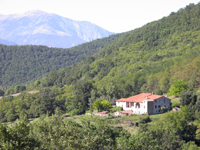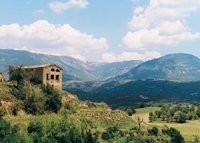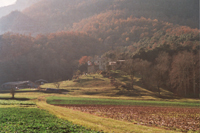Information of the project |
Can Boix
Sant Llorenç de Cerdans (Vallespir)A 'dialogue' between man and the earth
Farmhouses are important not only from the point of view of rural architecture. The way in which the society of this country is structured originates from and is nourished in our farmhouses: the finest blood in this country has come from these farmhouses, it still does and will continue to do so, their basic human strength, always active, positive and growing in all aspects.
Josep Pla
Of all the different elements that make up the structure of the population in Catalunya the “mas” —or “masada” or “masia” — probably has the most significant historical transcendence and is the most widely spread over the territory. This is because the “mas” or farmhouse is not simply a clear manifestation of popular architecture it is also the basic cell of the colonization of the Catalan territory throughout history. From this point of view is a true geographic micro-cosmos: a portion of nature that has been occupied by man since time immemorial, with the aim of changing it in a stable scenario for crop and cattle farming and timber production. The farmhouse in these areas has in fact become an institution, which is essential to ensure the survival and continuity for groups of people in practically all rural environments.
Those who are dedicated to studying the subject of farmhouses often remind us of the self-sufficient vocation of the farmhouse, from their origins and throughout most of their history. In the damper, temperate regions to the north touching the Pyrenees and to the east of the country and regions with rivers, (el Llobregat, el Besòs, la Tordera, el Ter, el Fluvià, el Tec, and la Tet), the climatic and ground conditions facilitate farming a various number of crops and agricultural products. The typical farm, in this context is a rural dwelling of varying size with the centre being the main farmhouse and with a series of clearly differentiated spaces each one suited to a different productive process and distance from the house: irrigated and non-irrigated crops, the orchard, the vineyards, the area for pasture, and the woodland. A similar specialization occurred also inside the main farmhouse, which at the best of times was the centre of operations for the entire farm with the farm labourer's dwellings acting as sub centres or subsidiaries to the main farmhouse.
Therefore if we understand the farmhouse to be a fundamental element in the ‘dialogue' between man and the earth and not just in our own particular geographical and historical setting then the farmhouse can be interpreted as the factor that has most contributed over the centuries to moulding the Catalan countryside —in both size and depth. If we understand the farmhouse as being the maximum representation throughout history as the unit for exploiting the land then it is evident that: forests, pastures, farmland or even barren lands, would not be as we see them today if it were not for the mark that these farmhouses have left on the land. Additionally human settlements: our villages, and some or many of the towns and cities that have their roots in the proximity between the primitive stable groups of the population and early neighbourhoods would not be, as we know them today. The farmhouse in one way or another is at the very root of this country, be this physical, biological or human. Its own endurance , inscribed on the genes of the word its-self which comes from the Latin verb “ manere”— ‘to stay' or ‘to remain', enables us to see the validity of the historic concept of ‘continuity' , that Jaume Vicens i Vives characterises as one of the essential bases of the collective Catalan personality.Joan Tort i Donada
Universitat de Barcelona
Roquer
Lladurs (Solsonès)
la Ruchetta
l'Alguer
les Comes
la Vall d'en Bas (Garrotxa)



